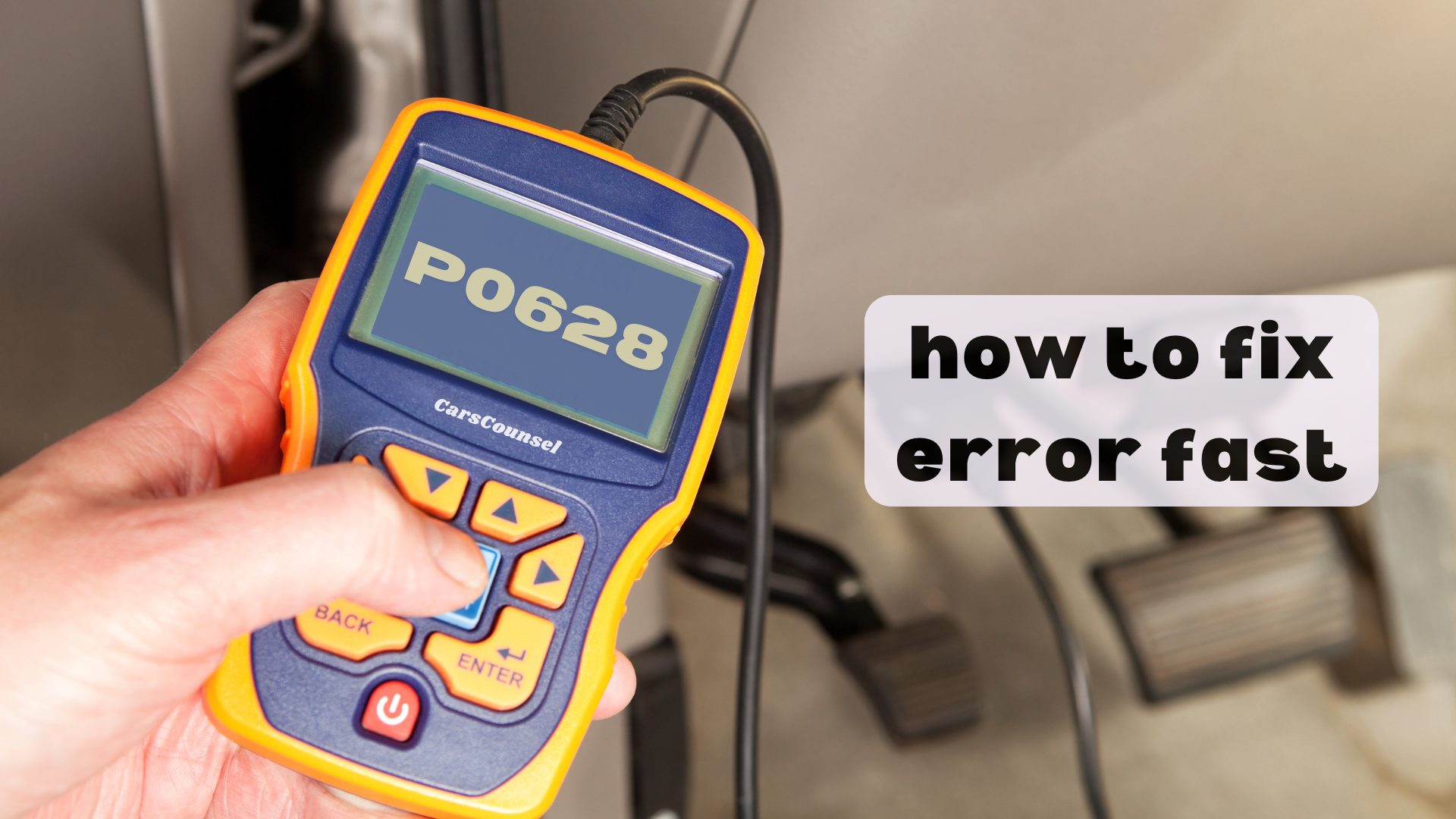You might not know that the P0628 code usually means there’s a problem with the fuel pump control circuit, which can mess up your car’s performance.
To fix this quickly, you’ll need an OBD-II scanner to find out the trouble code. After that, check the fuel pump control module, wiring, and connectors for any damage or rust.
Also, make sure to inspect the fuel pump relay and the fuel filter for any blockages.
Before you start, let’s go through each step so you can handle this issue smoothly and avoid more problems.

Quick Navigation
Key Takeaways
- Check and fix any damaged wires or connectors in the fuel pump circuit.
- Replace the bad fuel pump control module to get the fuel pressure working right again.
- Use an OBD-II scanner to read and clear the P0628 code after making repairs.
- Look at and change any clogged fuel filters that might be messing with the fuel pump.
What Is the P0628 Code
The P0628 code means there’s a problem with the fuel pump control module, which is especially common in diesel engine vehicles.
This code indicates an issue with how the fuel pump is managed, which is crucial for keeping the right fuel pressure in diesel engines. If this problem comes up, it can reduce engine performance and pose safety risks, so it’s important to fix it right away.
Diesel engines need exact fuel delivery, and any disruption can cause major issues. Understanding this code helps you diagnose and resolve the problem quickly, ensuring your vehicle runs properly.
Don’t ignore this code; it signals that your fuel pump control system needs immediate attention to avoid more serious problems.
Common Symptoms
Common signs of the P0628 code include the check engine light turning on and the car going into failsafe mode, which can greatly reduce its power and speed. You might find it hard to accelerate or keep up with highway speeds because the engine’s performance drops a lot.
Using diagnostic tools can help identify the exact problem by pulling up the trouble code. You might also have issues like rough idling or stalling, which make the car harder to drive.
Checking fuel pressure with these tools can show irregularities causing these problems. It’s important to fix these issues quickly to prevent more damage and keep your car running well.
Potential Causes
To figure out why your vehicle might be losing power and stalling, you need to look into several possible reasons for the P0628 code.
One common issue is a bad fuel pump control module, which affects different types of fuel pumps. Damaged wires or connectors can mess up the circuit, causing problems with the fuel pump.
Another possibility is a broken fuel pump relay, which is crucial for getting power to the pump. Sometimes, the fuel pump itself might be the problem due to clogged filters or bad regulators.
Lastly, a faulty powertrain control module (PCM) could be behind the P0628 code. Each of these parts should be carefully checked to fix the issue.
Ford Models Affected
Have you noticed that 2012-2018 Ford Focus models often have problems with the fuel pump control module, causing the P0628 code? This issue is common in diesel engine models and can seriously affect engine performance.
It’s crucial to keep the fuel pump in good shape in these vehicles. A faulty module can mess up fuel delivery, trigger the P0628 code, and reduce engine power and efficiency.
Regular checks and timely repairs of the fuel pump control module, wiring, and connectors are essential. Also, keeping the fuel system in good condition can help prevent these issues from coming back and keep your Ford Focus running well.
Always take care of any warning signs quickly to avoid bigger problems.
Chevrolet Models Affected
If you’re dealing with a P0628 code, you should know that 2011-2012 Chevy Cruze models often have problems with the fuel pump control module. Chevrolet says it’s important to fix these issues quickly to avoid bigger problems.
Some regular maintenance tips include checking the fuel pump control module, looking for damaged wiring, and making sure the connectors aren’t rusty.
If you see a P0628 code, use an OBD-II scanner to figure out what’s wrong. Often, replacing a bad fuel pump control module or fixing damaged wiring can solve the issue.
Also, regularly checking your car’s fuel system can help prevent this error code from coming back and keep your Chevrolet running smoothly.
Mercedes-Benz Vulnerabilities
Mercedes-Benz C-Class models from 2008-2014 have known issues with their fuel pump control systems, which can cause the P0628 error code.
Keeping the fuel pump in good condition is crucial for the diesel engine to run well. If the fuel pump control module fails, it can lead to irregular fuel delivery, affecting the engine’s performance and reliability.
Regularly check the fuel pump and its wiring for any signs of damage or corrosion. Replace any faulty parts right away to avoid the P0628 error.
Also, perform regular fuel pressure tests to ensure everything is working as it should. Properly maintaining the fuel pump and its control systems will help keep the car running smoothly and prevent expensive repairs in the future.
Dodge Diesel Issues
Dodge diesel vehicles often face more problems with the P0628 code because of how their fuel delivery system is designed. This can really affect the performance of your Dodge diesel. The P0628 code usually means there’s something wrong with the fuel pump control module circuit.
To keep your Dodge diesel running well, it’s important to stay on top of maintenance. Start by checking the fuel pump control module for any issues. Look at the wiring and connectors to see if there’s any rust or damage.
Make sure the fuel pump relay is working properly, as it powers the pump. You might need a professional mechanic to replace a faulty fuel pump.
Regularly servicing your Dodge diesel can help avoid future problems and ensure your vehicle runs smoothly.
Using an OBD-II Scanner
To diagnose the P0628 code in your vehicle, start by using an OBD-II scanner to read the trouble codes.
Plug the scanner into the diagnostic port under the dashboard. Turn on the ignition without starting the engine so the scanner can connect with the vehicle’s systems. Follow the instructions on the scanner to read the trouble codes.
If the P0628 code appears, use troubleshooting steps to find out what might be causing the problem. Note any other codes you find to get a complete picture of the issue.
Make sure to regularly update your scanner’s software for the best results. These steps will help you quickly identify and fix problems, preventing further issues.
Inspecting Wiring and Connectors
Checking the Wiring and Connectors
When you start inspecting, look closely at the wiring and connectors to spot any rust, worn-out areas, or loose connections that could mess up the fuel pump control system. Properly checking the wiring is crucial for good fuel pump maintenance.
Follow these easy steps:
- Look Over Everything: Check for any color changes, burn marks, or bare wires.
- Pull Gently: Lightly tug on connectors to make sure they’re firmly attached.
- Use a Multimeter: Test with a multimeter to see if the circuit has a continuous flow and the right voltage.
- Clean and Fix: Use a special cleaner to get rid of rust, and fix any worn-out wires or change out bad connectors.
Replacing the Fuel Pump
Replacing the fuel pump is often necessary when it can’t keep the fuel pressure high enough, which affects how well the engine runs.
First, make sure the car is safely lifted and the battery is disconnected. Drain the fuel tank to avoid spills. Take off the fuel tank straps and lower the tank carefully. Disconnect the fuel lines and electrical connectors from the pump.
Put in the new fuel pump by doing the removal steps in reverse. Taking good care of the fuel pump is important to avoid problems later on.
Regularly check the fuel filters and make sure the fuel lines are clean. Ignoring these steps can cause big problems like stalling and poor acceleration.
Always check your vehicle’s manual for specific instructions and think about getting professional help if you’re not sure.
More OBD-II Codes
Frequently Asked Questions
Can Driving With a P0628 Code Damage My Engine?
Yes, driving with a P0628 code can harm your engine. It reduces engine power, so you should diagnose and fix the problem quickly to avoid more damage and keep your engine in good shape.
How Long Does It Take to Replace a Fuel Pump Control Module?
Replacing a fuel pump control module usually takes about 1-2 hours. While you’re at it, make sure to check the fuel pump thoroughly to avoid any more problems. Depending on your vehicle’s model, it might take a bit more or less time.
Are Aftermarket Fuel Pump Control Modules Reliable?
When thinking about aftermarket fuel pump control modules, their reliability can be hit or miss. To ensure your fuel pump works well and lasts a long time without unexpected issues, choose trusted brands.
Do I Need Special Tools to Diagnose a P0628 Code?
You don’t need special tools, but using a basic OBD-II scanner can help you find the P0628 code. Also, you should take a good look at the fuel system, including the wiring and connectors, to check for any damage or rust.
What Is the Typical Cost of Labor for Fixing a P0628 Code?
Labor costs for fixing a P0628 code can be pricey. You’ll likely pay $100 to $200 for diagnostics, and total labor costs can range from $200 to $400.
Conclusion
In short, fixing the P0628 code quickly is crucial to keep your vehicle running well.
By using an OBD-II scanner and checking the wiring, connectors, and the fuel pump control module, you can often find the problem.
For example, John noticed his Ford F-150 was hesitating when he tried to accelerate.
After diagnosing the P0628 code, he discovered some corroded connectors. He replaced them and fixed the issue.
Taking immediate action can prevent more damage and ensure your vehicle runs smoothly.

